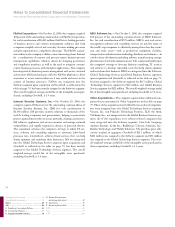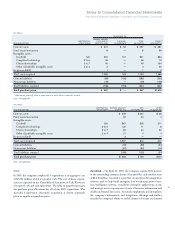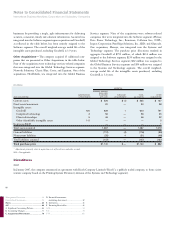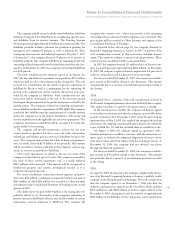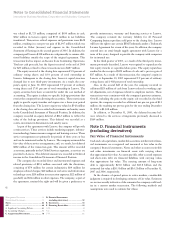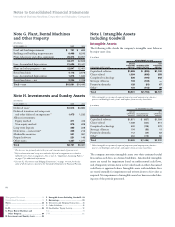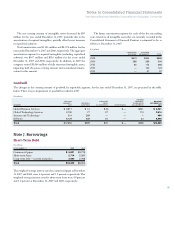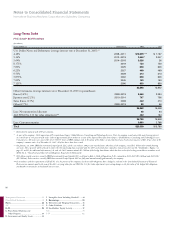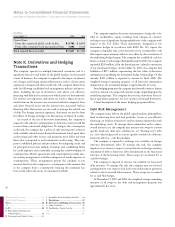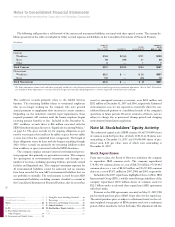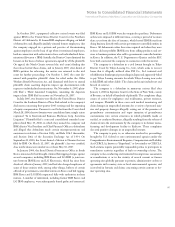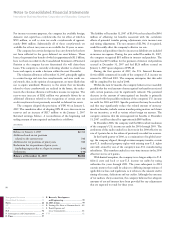IBM 2007 Annual Report Download - page 90
Download and view the complete annual report
Please find page 90 of the 2007 IBM annual report below. You can navigate through the pages in the report by either clicking on the pages listed below, or by using the keyword search tool below to find specific information within the annual report.
88
Notes to Consolidated Financial Statements
International Business Machines Corporation and Subsidiary Companies
Management Discussion ..................................14
Consolidated Statements ..................................58
Notes ........................................................... 64
A-F ...................................................................64
G-M ............................................................ 84
G. Plant, Rental Machines and
Other Property ...........................................84
H. Investments and Sundry Assets ..................84
I. Intangible Assets Including Goodwill ........84
J. Borrowings ............................................ 85
K. Derivatives and Hedging Transactions.. 88
L. Other Liabilities ..........................................91
M. Stockholders’ Equity Activity .....................92
N-S ...................................................................94
T-W ................................................................102
($ in millions)
AT DECEMBER 31: 2007 2006
Unused lines:
From the committed global credit facility $ 9,792 $ 9,875
From other committed and uncommitted lines 7,895 7,215
Total unused lines of credit $17,687 $17,090
Note K. Derivatives and Hedging
Transactions
The company operates in multiple functional currencies and is a
significant borrower and lender in the global markets. In the normal
course of business, the company is exposed to the impact of interest
rate changes and foreign currency fluctuations, and to a lesser extent
equity price changes and client credit risk. The company limits these
risks by following established risk management policies and proce-
dures, including the use of derivatives, and, where cost effective,
financing with debt in the currencies in which assets are denominated.
For interest rate exposures, derivatives are used to align rate move-
ments between the interest rates associated with the company’s lease
and other financial assets and the interest rates associated with its
financing debt. Derivatives are also used to manage the related cost
of debt. For foreign currency exposures, derivatives are used to limit
the effects of foreign exchange rate fluctuations on financial results.
As a result of the use of derivative instruments, the company is
exposed to the risk that counterparties to derivative contracts will fail
to meet their contractual obligations. To mitigate the counterparty
credit risk, the company has a policy of only entering into contracts
with carefully selected major financial institutions based upon their
credit ratings and other factors, and maintains strict dollar and term
limits that correspond to each institution’s credit rating. The com-
pany’s established policies and procedures for mitigating credit risk
on principal transactions include reviewing and establishing limits
for credit exposure and continually assessing the creditworthiness of
counterparties. Master agreements with counterparties include mas-
ter netting arrangements as further mitigation of credit exposure to
counterparties. These arrangements permit the company to net
amounts due from the company to a counterparty with amounts due
to the company from a counterparty reducing the maximum loss
from credit risk in the event of counterparty default.
The company employs derivative instruments to hedge the vola-
tility in stockholders’ equity resulting from changes in currency
exchange rates of significant foreign subsidiaries of the company with
respect to the U.S. dollar. These instruments, designated as net
investment hedges in accordance with SFAS No. 133, expose the
company to liquidity risk as the derivatives have an immediate cash
flow impact upon maturity which is not offset by the translation of
the underlying hedged equity. The company has established cash loss
limits to monitor and manage this liquidity risk. In 2007, the company
expended $258 million, all in the fourth quarter, related to maturities
of net investment hedges. At December 31, 2007, the company had
liabilities of $937 million, representing the fair value of derivative
instruments in qualifying net investment hedge relationships. Of this
amount, $495 million is expected to mature in fiscal 2008. The
weighted-average remaining maturity of all derivative instruments
designated as net investment hedges is approximately 1.5 years.
In its hedging programs, the company uses forward contracts, futures
contracts, interest-rate swaps and currency swaps, depending upon the
underlying exposure. The company does not use derivatives for trad-
ing or speculative purposes, nor is it a party to leveraged derivatives.
A brief description of the major hedging programs follows.
Debt Risk Management
The company issues debt in the global capital markets, principally to
fund its financing lease and loan portfolio. Access to cost-effective
financing can result in interest rate and/or currency mismatches with
the underlying assets. To manage these mismatches and to reduce
overall interest cost, the company uses interest-rate swaps to convert
specific fixed-rate debt into variable-rate (or “floating-rate”) debt
(i.e., fair value hedges) and to convert specific variable-rate debt into
fixed-rate debt (i.e., cash flow hedges).
The company is exposed to exchange rate volatility on foreign
currency denominated debt. To manage this risk, the company
employs cross-currency swaps to convert fixed-rate foreign currency
denominated debt to fixed-rate debt denominated in the functional
currency of the borrowing entity. These swaps are accounted for as
cash flow hedges.
The company is exposed to interest rate volatility on forecasted
debt issuances. To manage this risk, the company may use forward
starting interest-rate swaps to lock in the rate on the interest payments
related to the forecasted debt issuance. These swaps are accounted
for as cash flow hedges.
At December 31, 2007 and 2006, the weighted-average remaining
maturity of all swaps in the debt risk management program was
approximately five years.


